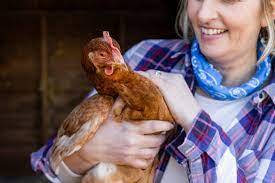The Jersey Giant Chicken is a unique type of chicken known for being gentle and big. In the United States in the late 1800s, this bird was first grown to replace turkeys as the main source of meat. Not only are Jersey Giants valued for their large meat production, but they are also valued for their consistent egg-laying skills. Let’s find out everything you need to know about this unique type of chicken.

History
Jersey Giant chickens originated in New Jersey, USA, in the late nineteenth century. John and Thomas Black had bred Black Javas, Brahmas, and Black Langshans in the 1870s. Jersey Giants were developed in 1870 and more famous in 1880.
Jersey Giants were admitted into the list of recognized breeds by the American Poultry Association in 1922. It was for its size and taste, and it laid many eggs and meat. A white variety gave it its name in 1947, while a blue gave it its name in 2002. Now, you can only find large jerseys in black, blue, and white.
Physical Characteristics
The Jersey Giant chicken is a beautiful breed known for being very big. A rooster is 5.9 kg and stands 24 to 28 inches tall. A hen is 4.5 kg and stands 18 to 22 inches tall. The back is long and slopes down. The wings and tail are well-feathered. The legs and feet are strong and yellow. The head is medium-sized and has a reddish-brown comb. You can tell their feathers apart by their three colors: black, white, and blue. They are thick, soft, and fluffy. Thanks to their large size and friendly personality, Jersey Giants are a popular choice for outdoor flocks and shows.
How many eggs does a Jersey hen lay?
Jersey Giant hens lay a lot of eggs. Each year, they lay about 200 to 220 big brown eggs on average. Around five months, they start laying eggs, and their peak production is between 1 and 2 years. Even though they aren’t the most prolific breed, Jersey Giants lay good eggs, given their main value is producing meat and being gentle.
Uses of the Jersey Giant Chicken
Here are the uses of Jersey Giant:
- Meat Production: Jersey Giants are raised for their tender, flavorful meat, which is very good quality.
- Egg Production: Hens lay 150 to 200 big brown eggs a year, which makes them a good choice for home flocks.
- Show Birds: Jersey Giants are popular as show birds because of their large size, high-quality feathers, and calm personality.
- Dual-Purpose Farming: Jersey Giants can be raised on a small scale because they produce eggs and meat.
- Backyard Pets: Jersey Giant Chickens are friendly, calm, and easy to handle, so they make great pets for families and hobbies.
Housing and Care Requirements
Space and Coop Size
They take up more space than most breeds as they are bigger and require more space than the Jersey Giant Chickens. Their coop should be big, and, in this case, they should make sure that they have adequate space for movement outside. If birds’ accommodations lack adequate space, the birds become unhealthy, and they will lay fewer eggs; each bird should always have adequate space to roam about.
Feeding and Diet
The Jersey Giant Chickens sure are starved! As they have to stretch and incubate eggs, they should be fed on foods rich in proteins. In addition to commercial feed, feeding them vegetables, grains, and occasional meals such as mealworms will go a long way in helping them.

How long does a Jersey Giant Chicken live?
A Jersey giant chicken can live for 6 to 8 years, but some have been known to live up to 10 to 12 years with the right care and control. Diet, health, and living situations are some of the things that affect how long someone lives.
Is the Jersey Giant Broody?
It is said that Jersey Giant hens are slightly broody, which means they like to sit on eggs and keep them warm. But they don’t lay as many eggs as some other kinds, so they’re good for backyard flocks and egg production.
Are Jersey Giants good mothers?
Yes, Jersey Giant hens make excellent mothers. They take care of their chicks, protect them from others, and produce healthy chicks. They are attentive and gentle.
What are the health problems of the Jersey Giant Chicken?
Jersey Giants may have health problems like leg and joint pain because they are so big. Also, they might get fat if they eat too much. Healthy food, enough space to live, and regular health checks can help reduce these problems.
Why Choose Jersey Giant Chickens?
Jersey Giants are great for backyard farms because they can be used for two things. In addition to giving us meat and eggs, they keep the yard calm and friendly. Because they are bigger, they are also safer from enemies than smaller breeds.
Conclusion
The Jersey Giants are a unique type of chicken that has a great mix of size, personality, and productivity. They are friendly and big, which makes them a great choice for farmers and hobbyists alike, whether you want to raise them for meat, eggs, or just as part of your garden flock.
FAQs
What makes Jersey Giants different from other chicken breeds?
Their size! Jersey Giants are one of the largest chicken breeds known for their dual-purpose use in meat and egg production.
How long does it take for Jersey Giants to reach full size?
Jersey Giants take about 8–10 months to reach their full size, which is longer than other breeds.
Are Jersey Giants suitable for small farms?
Yes! Jersey Giants are great for small farms as long as they have enough space to roam and a coop that can handle their size.
How many eggs do Jersey Giants lay per year?
Jersey Giant hens typically lay between 150–200 large brown eggs annually.
Can Jersey Giants be kept with other chicken breeds?
Yes, they generally get along well with other chickens due to their calm and docile nature.


